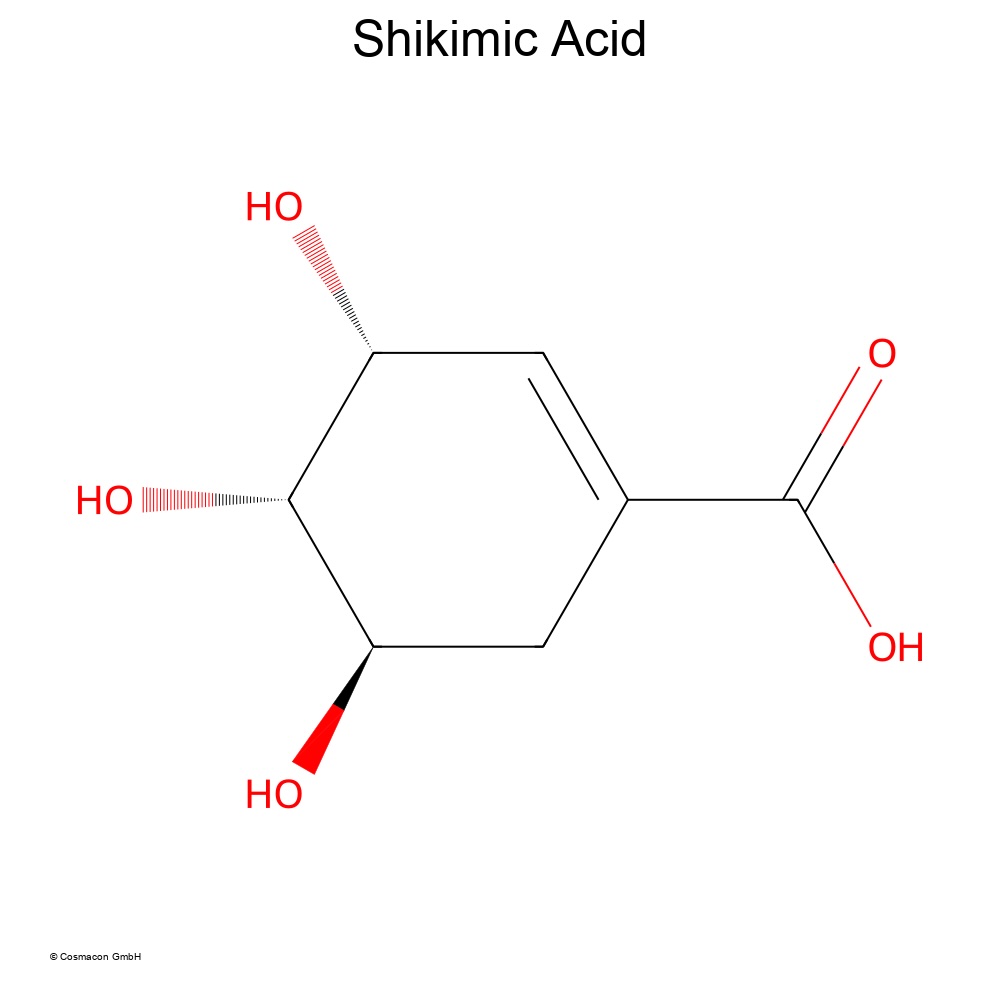Shikimic acid

Introduction
Shikimic acid is becoming increasingly important in the cosmetics industry. As a gentle alpha hydroxy acid (AHA), it has exfoliating, antioxidant, brightening and anti-inflammatory properties. This article takes a closer look at its mechanisms of action, its plant and biotechnological origins, its cosmetic applications and current studies on its effectiveness.
Origin and biosynthesis
Shikimic acid originates from the so-called shikimate pathway, a central metabolic pathway in plants, fungi and microorganisms that leads to the formation of aromatic amino acids. It is traditionally extracted from star anise (e.g. Illicium verum), but sustainable production via microbial fermentation is also possible.
Benefits and cosmetic effects
Exfoliation: 5% shikimic acid has an exfoliating effect comparable to 50% glycolic acid, but is much milder.
As an antioxidant and UV protector, it activates sirtuins and protects skin cells from UV-induced ageing.
Brightening: Effective tyrosinase inhibitor, proven in zebrafish and in vitro tests.
Anti-inflammatory and antibacterial: Reduces inflammatory mediators and acts against acne and mould fungi.
Skin regeneration: Promotes skin healing, cell remodelling and dermis reconstruction in ex vivo and in vivo tests.
Deodorising effect: Inhibits lipase activity and neutralises unwanted odours.
Scientific studies
Regeneration and reconstruction
Yoo-Wook Kwon et al. show that shikimic acid from sequoia callus converts human fibroblasts into skin precursor cells. In ex vivo skin models, it promotes wound healing and densification of the dermis. In a clinical study, significant increases in skin stem cell markers and collagen were observed after three weeks.
Antioxidant and UV-protective effects
In cell studies, shikimic acid demonstrated sirtuin activation and protection against UV-induced cell ageing, suggesting anti-ageing properties.
Exfoliation and improvement of skin appearance
A clinically evaluated study with a 3% formulation showed an improvement in skin micro-relief and an antioxidant effect in healthy subjects.
Brightening effect
Chen et al., 2016: In zebrafish and DPPH/ABTS assays, shikimic acid was identified as the most effective inhibitor of melanin formation with good antioxidant activity and low toxicity.
Regulation of inflammation and skin microbiome
Review 2021 (Batory & Rotsztejn): Anti-inflammatory, antimicrobial, anti-acne and antifungal properties have been documented.
Application in cosmetics
Exfoliants and serums containing 1–5% shikimic acid are suitable for gentle, daily use.
Toners and deodorants regulate oil production and neutralise odours.
Regenerating creams: for scar care and to support the skin structure (e.g. after laser treatments).
Fact sheet: Shikimic acid
Properties: Data
Molecular formula: C7H10O5
IUPAC name: (3R,4S,5R)-3,4,5-Trihydroxycyclohex-1-encarboxylic acid
CAS No.: 138-59-0
Physical state: colourless crystals
Melting point: 185–191 °C
Water solubility: approx. 180 g/l at 20 °C
INCI name: Shikimic Acid
Alternative names: Shikimate
Recommended concentration: 1–5% (cosmetic)
pH (5% solution): ≈ 3
Conclusion and recommendation
Shikimic acid combines a gentle exfoliating effect with antioxidant protection, brightening, anti-inflammatory and regenerative properties. This is backed by solid scientific evidence.
These properties are ideal for innovative cosmetic lines, for example:
– Regenerating serum (3%) with additional SPF – ideal for summer skin care after aesthetic treatments.
– Exfoliating toner for daily use on uneven skin tone and pigment spots.
– A post-treatment cream for inflammatory skin conditions.
The combination of plant extraction and fermentation creates sustainable raw materials that are ideal for strong brand positioning.
Secure your innovative edge now!
Take advantage of the diverse mechanisms of action of shikimic acid for your next product line! Whether as a gentle exfoliating component, brightening active ingredient or regeneration booster – we support you in developing tailor-made, effective and brand-enhancing cosmetic products.
Literature:
Kwon, Y.-W. et al. (2021) – Shikimic acid regenerates human skin by converting dermal fibroblasts into multipotent skin-derived precursor cells
Batory, D., Rotsztejn, H. (2021) – Shikimic acid in the light of current knowledge (Review)
➤ PubMed
Exfoliation Study (2015) – Shikimic acid: A potential active principle for skin exfoliation
➤ ResearchGate
Chen, Y.-H. et al. (2016) – Skin whitening capability and antioxidant properties of shikimic acid extracted from Illicium verum Hook. f.
➤ PubMed
DEAscàl – Wirkstoffdatenbank Shikimic Acid
➤ deascal.com